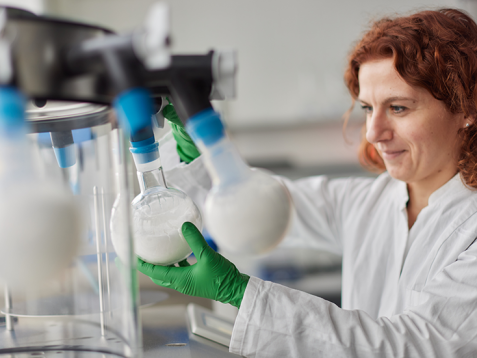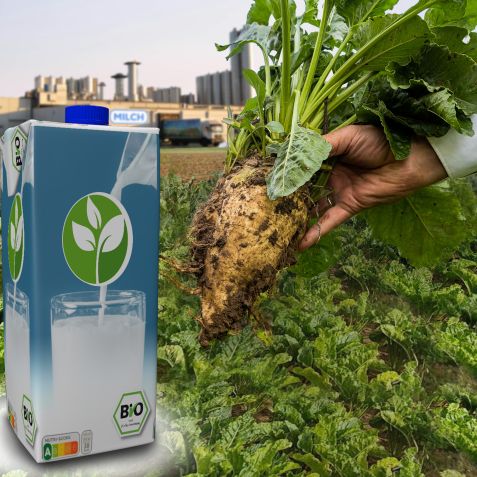MLZ is a cooperation between:
 > Technische Universität München
> Technische Universität München > Helmholtz-Zentrum Hereon
> Helmholtz-Zentrum Hereon
 > Forschungszentrum Jülich
> Forschungszentrum Jülich
MLZ is a member of:
 > LENS
> LENS > ERF-AISBL
> ERF-AISBL
MLZ on social media:

MLZ (eng)
Lichtenbergstr.1
85748 Garching
25.03.2024
Milk from green leaves
Milk alternatives made from sugar beet leaves – this is the vision of a Jülich research team. They have examined milk proteins and other components in cheese, yoghurt, cow’s milk and oat milk using X-rays and neutrons to find out what the structure of the products and individual components must be like in order for them to be stable, appealing and nutritious.
With oat and pea drinks, cow’s milk now has plant-based competition that promises to be much more environmentally friendly. A Jülich research team is now going even further.

Dr. Theresia Heiden-Hecht from Forschungszentrum Jülich is researching alternatives to cow's milk in the MLZ's food laboratory. © Bernhard Ludewig, FRM II / TUM
Alternatives to cow’s milk
“We are looking for sustainable alternatives to milk,” says Dr. Theresia Heiden-Hecht from Forschungszentrum Jülich, explaining the aim of her research. In terms of the circular economy, it would be sustainable to use sugar beet leaves, for example, which are currently still used as fertilizer during harvesting, to produce food.
It is well known that certain vegetable fats and proteins are better suited to forming an emulsion with water. It is also known that proteins help the oil droplets to form a stable milk liquid. Heiden-Hecht explains what makes a stable milk: “Unlike raw milk, for example, there is no cream layer on top of UHT milk.” But a good milk is also characterized by being nutritious and appealing to all the senses. Plant milk must also meet these high standards. “We know what it looks like, but the underlying macro- and micro-structure of the milk can only be identified using X-rays or neutrons,” says Heiden-Hecht.
The researchers analyzed conventional dairy products and oat milk using neutrons and X-rays. © Bernhard Ludewig, FRM II / TUM
Gouda and oat milk in X-ray light
For this reason, the food technologist first examined classic cow’s milk, yoghurt, cheese and oat milk more closely. Heiden-Hecht’s team used X-ray scattering at the MLZ and neutron scattering at the Paul Scherrer Institute in Switzerland. Previously, researchers had examined the products at different structural levels, such as the individual oil droplets in emulsions. “What’s new about our study is that we were able to identify the structure of the entire product on all length scales for the first time using small-angle X-ray and neutron scattering,” says Heiden-Hecht.

The researchers want to produce a milk alternative from the leaves of the sugar beet. © Dennis Möbus/Südzucker (photo: beet), from Leuband, CC BY-SA 3.0, https://commons.wikimedia.org/w/index.php?curid=31310507 (photo: diary), Editing: Reiner Müller, FRM II / TUM
Sugar beet leaves as milk suppliers
A methodology has now been developed. Next, the team will focus on plant proteins such as those from sugar beet leaves and has planned further neutron measurements. The aim is to highlight the differences to milk and dairy products and to find out what potential the proteins from green leaves have. Theresia Heiden-Hecht and doctoral student Maren Müller want to investigate this question in cooperation with Prof. Dr. Ute Weisz from the Chair of Plant Proteins and Nutrition at the Technische Universität Berlin.
Original publications:
T. Heiden-Hecht, B. Wu, M-S Appavou, S. Förster, H. Frielinghaus, O. Holderer.
Multiscale Structural Insight into Dairy Products and Plant-Based Alternatives by Scattering and Imaging Techniques. Foods 12, 2021 (2023).
DOI: 10.3390/foods12102021
T. Heiden-Hecht, B. Wu, K. Schwärzer, S. Förster, J. Kohlbrecher, O. Holderer, H. Frielinghaus
New insights into protein stabilized emulsions captured via neutron and X-ray scattering: An approach with β-lactoglobulin at triacylglyceride-oil/water interfaces.
Journal of Colloid and Interface Science 655, 319 (2024).
DOI: 10.1016/j.jcis.2023.10.155
MLZ is a cooperation between:
 > Technische Universität München
> Technische Universität München > Helmholtz-Zentrum Hereon
> Helmholtz-Zentrum Hereon
 > Forschungszentrum Jülich
> Forschungszentrum Jülich
MLZ is a member of:
 > LENS
> LENS > ERF-AISBL
> ERF-AISBL
MLZ on social media:


